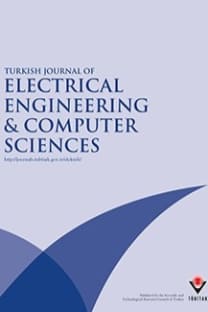Sensitivity analysis and optimum design for the stator of synchronous reluctance machines using the coupled finite element and Taguchi methods
Synchronous reluctance machines, Taguchi method, finite element method, orthogonal array, sensitivity analysis
Sensitivity analysis and optimum design for the stator of synchronous reluctance machines using the coupled finite element and Taguchi methods
Synchronous reluctance machines, Taguchi method, finite element method, orthogonal array, sensitivity analysis,
___
- (a) (b) –0.8 53 83 113 143 173 L (mm) 20 1 3 5 7 9 11131517192123252729313335373941 Harmonic order
- Figure 14. Air gap flux density: a) flux distribution and b) harmonic content after optimization (percentage of fundamental components: 0.455 T and 0.522 T for the initial and optimum design, respectively) using FEA. 0.5 0.000030.00450.0060.00750.0090.01050.0120.01350.015 Time (s)
- J. Lee, “Optimum design criteria for maximum torque density and minimum torque ripple of SynRM according to the rated wattage using response surface methodology”, IEEE Transactions on Magnetics, Vol. 45, pp. 1578–1581, 200
- J. Lee, K. Lee, Y.H. Cho, T.W. Yun, “Characteristics analysis and optimum design of anisotropy rotor synchronous reluctance motor using coupled finite element method and response surface methodology”, IEEE Transactions on Magnetics, Vol. 45, pp. 4696–4699, 2009.
- J.M. Park, S. Kim, J.P. Hong, J.H. Lee, “Rotor design on torque ripple reduction for a synchronous reluctance motor with concentrated winding using response surface methodology”, IEEE Transactions on Magnetics, Vol. 42, pp. 3479–3481, 2006.
- S. Giurgea, D. Fodorean, G. Cirrincione, A. Miraoui, M. Cirrincione, “Multimodel optimization based on the response surface of the reduced FEM simulation model with application to a PMSM”, IEEE Transactions on Magnetics, Vol. 44, pp. 2153–2157, 2008.
- D.K. Hong, B.C. Woo, D.H. Koo, D.H. Kang, “Optimum design of transverse flux linear motor for weight reduction and improvement thrust force using response surface methodology”, IEEE Transactions on Magnetics, Vol. 44, pp. 4317–4320, 2008.
- N. Bianchi, S. Bolognani, D. Bon, M. Dai Pre, “Rotor flux-barrier design for torque ripple reduction in synchronous reluctance and PM-assisted synchronous reluctance motors”, IEEE Transaction on Industry Applications, Vol. 45, pp. 921–928, 2009.
- X.B. Bomela, M.J. Kamper, “Effect of stator chording and rotor skewing on performance of reluctance synchronous machine”, IEEE Transactions on Industry Applications, Vol. 38, pp. 91–100, 2002.
- Y.C. Choi, J.H. Lee, “Rotor & stator design on torque ripple reduction for a synchronous reluctance motor with a concentrated winding using RSM”, Proceedings of the International Conference on Electrical Machines and Systems, pp. 1216–1221, 2007.
- H. Hofmann, S.R. Sanders, “High-speed synchronous reluctance machine with minimized rotor losses”, IEEE Transactions on Industry Applications, Vol. 36, pp. 531–539, 2000.
- A. Fratta, G.P. Troglia, A. Vagati, F. Villata, “Torque ripple evaluation of high-performance synchronous reluctance machines”, IEEE Industry Applications Magazine, Vol. 1, pp. 14–22, 1995.
- D.A. Staton, S.E. Wood, T.J.E. Miller, “Maximising the saliency ratio of the synchronous reluctance motor”, Electric Power Applications, IEE Proceedings B, Vol. 140, pp. 49–59, 1993.
- P. Niazi, H. Toliyat, D. Cheong, J. Chul Kim, “A low-cost and efficient permanent-magnet-assisted synchronous reluctance motor drive”, IEEE Transactions on Industry Applications, Vol. 43, pp. 542–550, 2007.
- J.W. Kim, B.T. Kim, “Optimal stator slot design of inverter-fed induction motor in consideration of harmonic losses”, IEEE Transactions on Magnetics, Vol. 41, pp. 2012–2015, 2005.
- S. Brisset, F. Gillon, S. Vivier, P. Brochet, “Optimization with experimental design: an approach using Taguchi’s methodology and finite element simulations”, IEEE Transactions on Magnetics, Vol. 37, pp. 3530–3533, 2001.
- S. Kamaruddin, Z.A. Khan, S.H. Foong, “Application of Taguchi method in the optimization of injection moulding parameters for manufacturing products from plastic blend”, International Journal of Engineering and Technology, Vol. 2, pp. 574–580, 2010.
- P. Georgilakis, “Taguchi method for the optimization of transformer cores annealing process”, Journal of Optoelec- tronics and Advanced Materials, Vol. 10, pp. 1169–1177, 2008.
- L.A. Dobrzanski, J. Domaga, J.F. Silva, “Application of Taguchi method in the optimisation of filament winding of thermoplastic composites”, Archives of Materials Science and Engineering, Vol. 28, pp. 133–140, 2007.
- ISSN: 1300-0632
- Yayın Aralığı: Yılda 6 Sayı
- Yayıncı: TÜBİTAK
A new systematic and flexible method for developing hierarchical decision-making models
Ulaş BELDEK, Mehmet Kemal LEBLEBİCİOĞLU
Mohamed MOUTCHOU, Ahmed ABBOU, Hassan MAHMOUDI
Seyed Mehdi RAKHTALA, Abolfazl Ranjbar NOEI, Reza GHADERI, Elio USAI
Optimization of grid connected micro-grid consisting of PV/FC/UC with considered frequency control
Hamid HASSANZADEHFARD, Seyed Masoud MOGHADDAS-TAFRESHI, Seyed Mehdi HAKIMI
Asaf Behzat ŞAHİN, Hatice Gonca BULUR
A hierarchic approach based on swarm intelligence to solve the traveling salesman problem
Mesut GÜNDÜZ, Mustafa Servet KIRAN, Eren ÖZCEYLAN
Reza Omidi GOSHEBLAGH, Karim MOHAMMADI
Adaptive network-based inference system models on multiband patch antenna design
Erdem DEMİRCİOĞLU, Murat Hüsnü SAZLI, Orhan ŞENGÜL, Şehabeddin Taha ˙IMECİ, Hakkı Alparslan ILGIN
